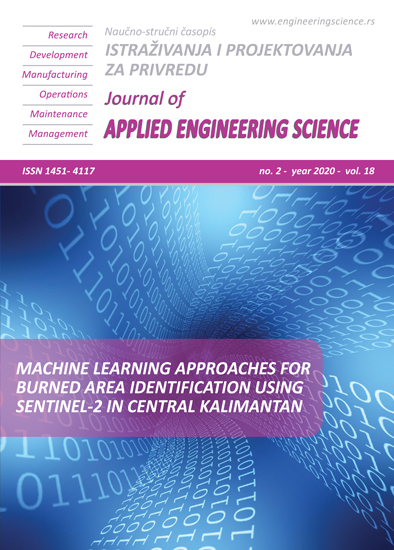THE GEOMETRY OF SOLAR RADIATION ENERGY EQUILIBRIUM DISTRIBUTION ON DOUBLE-PASS SOLAR AIR HEATER WITH THE ADDITION OF FIN ELEMENTS: CASE STUDY IN LIBYA
Abstract
The drying process is the most important process in the Libyan agricultural sector for agricultural products export value. Libya uses a direct drying system from solar radiation, but it provides a large energy loss and decreases the agricultural products quality. Solar air heater technology was developed to solve these problems. One indicator of the solar air heater performance is influenced by the solar radiation energy absorption distribution to heat the airflow, which can be seen from the changes in air temperature and influences the thermal efficiency. The addition of fin elements can optimize these mechanisms. This research was conducted to analyze the effect of fin elements (geometry and fin number) on air temperature rise through three methods i.e. measurement of air flow characteristics, heat transfer rate and thermal efficiency of solar air heater. The results showed that fin elements with a length of 1 m and a high range between 0.197 m to 0.221 m and the fin number of 10 pieces were able to increase the air temperature from 350C to 71.80C so that the thermal efficiency of solar air heater reached 51.5%. The performance of this technology can be applied to the agricultural products drying process in Libya.
References
Lambert, D., McKoy, S. (2009). Trade creation and diversion effects of preferential trade associations on agricultural and food trade. Journal of Agricultural Economics, vol.60, 17–39.
Sivakumar,R.,Saravanan,R.,Elaya Perumal,A.,Iniyan,S.(2016).Fluidized bed drying of some agro products - A review. Renewable and Sustainable Energy Reviews,vol.61,280–301.
Eltawil,MA., Azam,MM.,Alghannam,AO.(2018).Solar PV powered mixed-mode tunnel dryer for drying potato chips. Renewable Energy, vol.116,594–605.
Sharada,S.(2013).Studies on effect of various operating parameters & foaming nagents- Drying of fruits and vegetables.Ijmer,vol.3,1512–1519.
Alosaimy,AS.(2013).Application of Evaporative Air Coolers Coupled With Solar Water Heater for Dehumidification of Indoor Air. International Journal of Mechanical & Mechatronics Engineering IJMEE-IJENS, vol.13,60–68.
Darhmaoui,H., Lahjouji,D.(2013).Latitude based model for tilt angle optimization for solar collectors in the mediterranean region. Energy Procedia.vol.42,426–435.
Mkharem,M., Adam,N., Supeni,E., Mustapha,S.(2017).Fire severity prediction analysis of a traditional libya house roofing materials: A case study. Journal of Mechanical Engineering and Sciences,vol.11,2952–2966.
Glaisa,KA., Elayeb,ME., Shetwan,MA.(2014).Potential of hybrid system powering school in Libya. Energy Procedia,vol.57,1411–1120.
Mohamed,AMA., Al-Habaibeh,A., Abdo,H.(2013).An investigation into the current utilisation and prospective of renewable energy resources and technologies in Libya. Renewable Energy,vol.50,732–740.
Brown,B., Nuberg,I., Llewellyn,R.(2018).Constraints to the utilisation of conservation agriculture in Africa as perceived by agricultural extension service providers. Land Use Policy,vol.73,331–340.
Tyagi,V V., Panwar,NL., Rahim,NA., Kothari,R.(2012).Review on solar air heating system with and without thermal energy storage system. Renewable and Sustainable Energy Reviews,vol.16,2289–2303.
Sansaniwal,SK.,Kumar,M.(2015).Analysis of ginger drying inside a natural convection indirect solar dryer: An experimental study. Journal of Mechanical Engineering and Sciences,vol.9,1671–1685.
Hosseini,SS.,Ramiar,A.,Ranjbar,AA.(2018).Numerical investigation of natural convection solar air heater with different fins shape. Renewable Energy,vol.117:488–500.
Kumar,R., Rosen,MA.(2011).Performance evaluation of a double pass PV/T solar air heater with and without fins. Applied Thermal Engineering,vol.31,1402–1410.
Mahmood,AJ., Aldabbagh,LBY., Egelioglu,F.(2015).Investigation of single and double pass solar air heater with transverse fins and a package wire mesh layer. Energy Conversion and Management,vol.89,599–607.
Fudholi,A.,Sopian,K.,Yusof,M.,Hafidz,M.,Bakhtyar,B.(2013).Energy analysis and improvement potential of finned double-pass solar collector. Energy Conversion and Management,vol.75,234–240.
Ramani,BM., Gupta,A., Kumar,R.(2010).Performance of a double pass solar air collector. Solar Energy,vol.84,1929–1937.
Priyam,A., Chand,P.(2016).Thermal and thermohydraulic performance of wavy finned absorber solar air heater. Solar Energy,vol.130,250–259.
Mojumder,JC., Chong,WT., Ong,HC., Leong,KY.(2016).An experimental investigation on performance analysis of air type photovoltaic thermal collector system integrated with cooling fins design. Energy & Buildings,vol.130,272–285.
Alam,T., Kim,MH.(2017).Performance improvement of double-pass solar air heater – A state of art of review. Renewable and Sustainable Energy Reviews,vol.79,779–793.
Nowzari,R., Aldabbagh,LBY., Egelioglu,F.(2014). Single and double pass solar air heaters with partially perforated cover and packed mesh. Energy,vol.73,694–702.
Priyam,A., Chand,P.(2018). Effect of wavelength and amplitude on the performance of wavy finned absorber solar air heater. Renewable Energy,vol.119,690–702.
Rai,S., Chand,P., Sharma,SP.(2018).Evaluation of thermo hydraulic effect on offset finned absorber solar air heater. Renewable Energy,vol.125,39–54.
Kumar,R., Chand,P.(2017).Performance enhancement of solar air heater using herringbone corrugated fins. Energy,vol.127,271–279.
Fan,W., Kokogiannakis,G., Ma,Z., Cooper,P.(2017).Development of a dynamic model for a hybrid photovoltaic thermal collector – Solar air heater with fins. Renewable Energy,vol.101,816–834.
Good,P., Cooper,T., Querci,M., Wiik,N., Ambrosetti,G., Steinfeld,A.(2016).Spectral reflectance, transmittance, and angular scattering of materials for solar concentrators. Solar Energy Materials and Solar Cells,vol.144,509–522.
Salleh,N., Shamsudin,Z., Juoi,J., Mustafa,Z.(2017).Effects of heating rates and SBE loading on sintered properties of spent bleach earth/recycled glass composite. Journal of Mechanical Engineering and Sciences,vol.11,3104–3115.
Yoshida,K., Morigami,H.(2004).Thermal properties of diamond/copper composite material. Microelectronics Reliability,vol.44,303–308.
Boubault,A., Ho,CK., Hall,A., Lambert,TN., Ambrosini,A.(2017).Durability of solar absorber coatings and their cost-effectiveness. Solar Energy Materials and Solar Cells,vol.166,176–84.
Limam,A., Zerizer,A., Quenard,D., Sallee,H., Chenak,A.(2016). Experimental thermal characterization of bio-based materials (Aleppo Pine wood, cork and their composites) for building insulation. Energy and Buildings,vol.116,89–95.
Carvalho,R., Fernandes,M., Fangueiro,R.(2017). The influence of cork on the thermal insulation properties of home textiles. Procedia Engineering,vol. 200,252–259.
Yogesh,SS., Selvaraj,AS., Ravi,DK., Rajagopal,TKR.(2018). Heat transfer and pressure drop characteristics of inclined elliptical fin tube heat exchanger of varying ellipticity ratio using CFD code. International Journal of Heat and Mass Transfer, vol.119,26–39.
Naphon,P.(2005). On the performance and entropy generation of the double-pass solar air heater with longitudinal fins. Renewable Energy,vol.30,1345–1357.
Alta,D., Bilgili,E., Ertekin,C, Yaldiz,O.(2010). Experimental investigation of three different solar air heaters: Energy and exergy analyses. Applied Energy,vol.87,2953–2973.
Watmuff, J H., Charters,W., Proctor,D.(1997) Solar and wind induced external coefficients for solar collectors. COMPLES,vol.2,56.
Grag,H., Jha, R., Choudry, C., Datta, G.(1991). Theoretical analysis on a new finned type solar air heater. Energy,vol.16,1231–1238.

